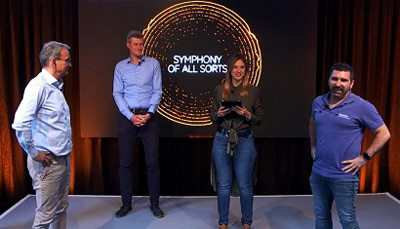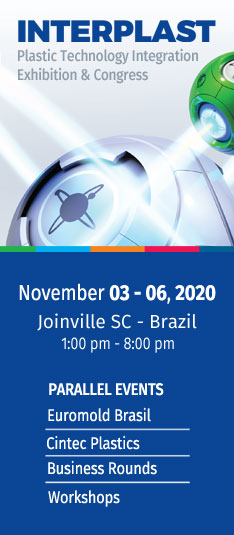| Plastics News |
Tomra Sorting Recycling launches its latest and advance sorting solutions via digital conference
Tuesday 9, June, 2020 marked the global launch of Tomra Sorting Recycling’s latest advanced sorting solutions to meet demand for faster, more efficient and smarter material sorting – both now and in the future. Under the theme of ‘Symphony of all Sorts’, Tomra Sorting Recycling formally launched two brand new products – Tomra’s new generation technology Autosort and Autosort SpeedAir, and also outlined plans for the forthcoming launch of a third new solution, Autosort Cybot. The product launches were originally due to take place at IFAT 2020, but with the event cancelled due to Covid-19, Tomra adapted its plans and instead launched the new products on a digital platform. The ‘Tomra’s Symphony of all Sorts’ theme was chosen to reflect the way in which the latest generation Autosort and its complementary products create a perfectly harmonised symphony to sort all kinds of waste with advanced accuracy and sophistication. Experts from across Tomra’s global teams delivered presentations about the latest products to more than 1000 digital delegates world-wide, including representatives from a number of international and regional press titles. Interactive Q&A sessions enabled delegates to find out more about the new products’ capabilities and hear about Tomra’s predictions for the global future of sensor-based sorting. Based on the positive feedback received from delegates, Tomra Sorting anticipates high levels of interest in the most advanced model of its New generation Autosort system. The highly ultra-compact versatile sensor-based sorting system can be used across a vast range of material sorting applications. Compact, highly flexible and upgradable, Autosort brings together the very latest in Tomra’s technologies to deliver advanced accuracy of complex sorting tasks at high throughput rates. The system can be easily integrated into any existing or new sorting processes, as a great number of initial pilot projects have confirmed. Being equipped with the broadest range of sensors and using data to classify objects, the machine is capable of separating materials which are difficult, or even impossible to separate using conventional technologies. Incorporated as standard in the latest Autosort is Tomra’s Sharp Eye technology which increases the light efficiency while maintaining the same energy consumption, enhances sorting sharpness and improves the separation of difficult to target fractions. The unit also incorporates the latest and improved version of Tomra’s unique and patented advanced Flying Beam sensing technology which delivers a range of benefits. Better light efficiency enables higher performance at low operating costs; compact design enables flexible and easy installation; and enhanced light signal efficiency results in improved detection. Thanks to the integration of Sharp Eye and Flying Beam technology, Autosort consistently delivers high performance in terms of sorting accuracy across all target fractions – even in the most complex of applications. Optional technologies include the new Deep Laiser which stands out for its compactness and flexible range of uses. Its object recognition enables a deeper sorting sharpness to significantly improve the performance of the sorting process. Another application area is the use of Artificial Intelligence via Deep Learning. Deep Laiser is one of the first fully integrated Deep Learning systems on the market. Fabrizio Radice, Vice President and Head of Global Sales and Marketing at Tomra Sorting Recycling, comments: “We work very closely with our customers to ensure that our products consistently meet their demanding requirements and those of their end customers. Our New generation Autosort system is an incredibly exciting development as its use of versatile sensors and intelligent software will enable it to meet the demands of a whole host of current and future sorting applications.” Delegates of Tomra’s digital launch event also found out about another new product developed by Tomra – Autosort SpeedAir – an additional component to Tomra’s Autosort range. Autosort SpeedAir is a highly customisable system designed to stabilise light materials such as plastic films or paper on a highspeed conveyor, thus generating a higher throughput and enhancing sorting quality. With industry demand resulting in the need for higher speed conveyor belts, Autosort SpeedAir incorporates speed-controlled fan-driven air inlets that generate a constant air stream over the conveyor belt to prevent material on the conveyor belt from moving. By doubling the speed of the conveyor belts up to 6 metres per second, throughput is much higher and the output quality is consistently high. Customers benefit from a better return on investment, as well as lower installation and running costs. Additionally, as the first system on the market with no belt cover, access to the unit for maintenance is much faster and the likelihood of a material blockage is much lower compared to conventional high speed systems in the market, as is the risk of machine downtime. Looking beyond the launch of the new generation Autosort and Autosort SpeedAir, the third and final product mentioned at the event was the forthcoming launch of Tomra’s first robot, the Autosort Cybot. The system comprises a new generation Autosort scanner, an electromagnetic sensor and a robot arm. It is the first robot on the market that combines four technologies at once: Near Infrared (NIR) and Visible Light (VIS) spectroscopy, Deep Laiser and if required, induction for ferrous and non-ferrous metals recovery. Autosort Cybot’s robotic arm is capable of simultaneously sorting material into four different streams or fractions depending on the infeed material size, colour and criteria of the target fractions. With sorting and recycling plants demanding even higher levels of automation than ever before, the Autosort Cybot will available soon and is another value-added component that complements the Autosort range, but can also operate as a standalone unit. Prior to its official launch, material tests can be carried out at Tomra's Test Center to confirm its outstanding capabilities. Valerio Sama, Vice President and Head of Product Management, adds: “The addition of a robot arm to our Autosort system opens up a wealth of new opportunities for highly automated applications within the sorting process and will deliver an even higher level of quality control of recyclables such as HDPE, PET and PP.” Tom Eng, SVP and Head of Tomra Sorting Recycling, concludes: “We are delighted with how well the digital launch event went. Covid-19 has enforced new ways of working and communicating and as such we were more than happy to test out a digital launch platform for the first and probably not the last time given its success! The launch provided an opportunity to showcase our range of complementary, connected and perfectly harmonised technologies which together deliver a symphony that is capable of sorting all sorts of waste at unparalleled sorting performances and with impressive throughput and yield. Delegates had the chance to listen to the symphony – the sounds of all our machines – and were captivated by it!” Tomra Sorting Recycling designs and manufactures sensor-based sorting technologies for the global recycling and waste management industry. Over 6,000 systems have been installed in more than 100 countries worldwide. Responsible for developing the world’s first high capacity Near Infrared (NIR) sensor for waste sorting applications, Tomra Sorting Recycling remains an industry pioneer with a dedication to extracting high purity fractions from waste streams that maximize both yield and profits. Tomra Sorting Recycling is part of Tomra Sorting Solutions which also develops sensor-based systems for sorting, peeling and process analytics for the food, mining and other industries. Tomra Sorting is owned by Norwegian company Tomra Systems ASA, which is listed on the Oslo Stock Exchange. Founded in 1972, Tomra Systems ASA has a turnover of around €876m and employs ~4,000 globally. Source: Tomra |


